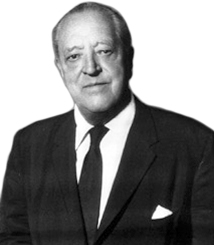
VAN DER ROHE
1886 – 1969
Born in Aachen in 1886, Van de Rohe finished business school and then entered his father’s stonecutting business.
In 1905 he moved to Berlin where he worked as a furniture designer in the studio of Bruno Paul.
In 1908 he began to work for Peter Behrens and met Gropius and Le Corbusier. Here Mies had the opportunity to get to know the work of the great German Neo-classical architect Schinkel.
He would have a great influence on his first buildings. In 1910 he discovered a world different from that of Behrens, through works of Wright’s in Berlin.
Mies abandoned his first expression of Neoclassic inspiration and approached the Dutch De Stijl movement and Constructivism, beginning to design with an innovative use of steel and glass. His architecture is not distinguished from structure and technique and rejects any form that is not ruled by structure. In 1929 he designed the German pavilion for Barcelona’s International Exhibition, where Mies presented his vocabulary of architecture in a
poetic manner, praising the possibility. The planes of the walls extend below the flat and almost suspended cover of the ceiling, becoming one with the abstract surfaces of the workshop.
Interior and exterior spaces meet harmoniously.
This new formal language reached its peak with the International Style. Its social, aesthetic and technical principles were also applied in the design of interiors. The new spatial concepts allowed the evolution of mobility, an equally important concept for the role of the buildings of the period for modern architecture.
The first seat designed by Mies using steel tubes was characterized by slender elegance and complete and clear shape. In the slender, elegant design, Mies also turned towards “maximum effect with minimum waste of resources”. It is the birth of a new expressive language applied to objects, studying and using the smallest details, completely purified of any superfluous objective approach.
At the end of the 1930s he left Nazi Germany, moving to the United States where he settled in Chicago. Towards the end of his life, Mies achieved the vision of a monumental “skin and bones” architecture; in fact his last work offers a vision of a universal simplified and essential architecture.
He died in Chicago, in 1969.


